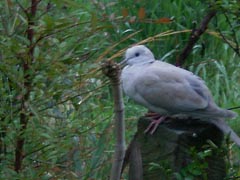White-tailed Deer (Odocoileus virginianus), Glen Burnie, Maryland, September 2015. Photo by Diane F. Evartt.

Eurasian Collared-Dove (Streptopelia decaocto), Glen Burnie, Maryland, April 2011. Photo by Diane F. Evartt.
![[photo, Barn spider (Neoscona crucifera), Baltimore, Maryland]](/msa/mdmanual/01glance/wildlife/arachnids/images/1198-1-07834b.jpg)
![[photo, Bracket or Shelf Fungi, Lake Waterford Park, Pasadena, Maryland]](/msa/mdmanual/01glance/wildlife/fungi/images/1198-1-09305b.jpg)
![[photo, White-tailed Deer (Odocoileus virginianus), Glen Burnie, Maryland]](/msa/mdmanual/01glance/wildlife/mammals/images/1198-1-07344b.jpg)
White-tailed Deer (Odocoileus virginianus), Glen Burnie, Maryland, September 2015. Photo by Diane F. Evartt.

Eurasian Collared-Dove (Streptopelia decaocto), Glen Burnie, Maryland, April 2011. Photo by Diane F. Evartt.
![[photo, Barn spider (Neoscona crucifera), Baltimore, Maryland]](/msa/mdmanual/01glance/wildlife/arachnids/images/1198-1-07834b.jpg)
![[photo, Bracket or Shelf Fungi, Lake Waterford Park, Pasadena, Maryland]](/msa/mdmanual/01glance/wildlife/fungi/images/1198-1-09305b.jpg)
Barn spider (Neoscona crucifera) (left), Baltimore, Maryland, September 2016. Photo by Sarah A. Hanks.
Bracket or Shelf Fungi (right), Lake Waterford Park, Pasadena, Maryland, October 2018. Photo by Diane F. Evartt.
![[photo, Virginia Opossum (Didelphis virginiana), Irvine Nature Center exhibit at Ladew Topiary Gardens, 3535 Jarrettsville Pike, Monkton, Maryland]](/msa/mdmanual/01glance/wildlife/mammals/images/1198-1-10128b.jpg)
![[photo, Eastern Cottontail Rabbit (Sylvilagus floridanus) in grass with early wildflowers, Glen Burnie, Maryland]](/msa/mdmanual/01glance/wildlife/mammals/images/1198-1-08482b.jpg)
Virginia Opossum (Didelphis virginiana), Irvine Nature Center exhibit at Ladew Topiary Gardens, 3535 Jarrettsville Pike, Monkton, Maryland, October 2019. Photo by Sarah A. Hanks.
Eastern Cottontail Rabbit (Sylvilagus floridanus) in grass with early wildflowers, Glen Burnie, Maryland, April 2018. Photo by Diane F. Evartt.
![[photo, Eastern Box Turtle (Terrapene c. carolina), Glen Burnie, Maryland]](/msa/mdmanual/01glance/wildlife/reptiles/images/1198-1-08172b.jpg)
Since the earliest days of colonial settlement, Maryland has been described as a land of natural beauty. Situated on the border between temperate and tropical climes, with access to both salt and fresh waters, the State offers a unique diversity in topography and biology.
Eastern Box Turtle (Terrapene c. carolina), Glen Burnie, Maryland, June 2017. Photo by Diane F. Evartt.
![[photo, Catalpa sphinx caterpillar, Glen Burnie, Maryland]](/msa/mdmanual/01glance/wildlife/insects/images/1198-1-06610
b.jpg) Throughout the State, the Wildlife and Heritage Service of the Department of Natural Resources oversees Wildlife Management Areas. These 64 protected areas total 126,798 acres, and may offer limited recreational activities.
Throughout the State, the Wildlife and Heritage Service of the Department of Natural Resources oversees Wildlife Management Areas. These 64 protected areas total 126,798 acres, and may offer limited recreational activities.
Fishing and Boating Services of the Department of Natural Resources manages Maryland's Fishery Management Areas. These 1,165 acres include State hatcheries as well as public areas for fishing and boating.
Catalpa sphinx caterpillar, Glen Burnie, Maryland, September 2014. Photo by Diane F. Evartt.
![[photo, Eastern Snapping Turtle (Chelydra s. serpentina), Annapolis, Maryland]](/msa/mdmanual/01glance/wildlife/reptiles/images/1198-1-5957a.jpg) Countless different species* may be observed in Maryland's natural areas, and are divided by numerous physical features. The most abundant families are amphibia (amphibians); arthropods (crustaceans, insects, & spiders); aves (birds); mammalia (mammals); and reptilia (reptiles). Often, they are classified further by diet, as carnivores, herbivores, and omnivores, although this division can be narrowed to define specific dietary habits, such as insectivores.
Countless different species* may be observed in Maryland's natural areas, and are divided by numerous physical features. The most abundant families are amphibia (amphibians); arthropods (crustaceans, insects, & spiders); aves (birds); mammalia (mammals); and reptilia (reptiles). Often, they are classified further by diet, as carnivores, herbivores, and omnivores, although this division can be narrowed to define specific dietary habits, such as insectivores.
*(specific animals are classified by eight main taxonomic ranks: domain; kingdom; phylum; class; order; family; genus; and species)
Eastern Snapping Turtle (Chelydra s. serpentina), Annapolis, Maryland, May 2012. Photo by Diane F. Evartt.
![[photo, Mallards (Anas platyrhynchos), Glen Burnie, Annapolis, Maryland]](/msa/mdmanual/01glance/wildlife/birds/images/1198-1-08179c.jpg)
Maryland maintains nearly forty thousand acres of wildlands, which are encompassed by State parks, forests, and wildlife management areas. These areas allow for Maryland's natural wildlife to thrive virtually undisturbed. State wildlands are protected by law, and are monitored and protected by the Natural Resources Police Force.
Mallards (Anas platyrhynchos), Glen Burnie, Annapolis, Maryland, July 2017. Photo by Diane F. Evartt.
![[photo, Great Blue Heron (Ardea herodias), College Creek, Annapolis, Maryland]](/msa/mdmanual/37mun/annapolis/images/1198-1-4472.jpg)
Great Blue Heron (Ardea herodias), College Creek, Annapolis, Maryland, July 2010. Photo by Diane F. Evartt.
![[photo, Carolina Mantid (Stagmomantis carolina), Baltimore, Maryland]](/msa/mdmanual/01glance/wildlife/insects/images/1198-1-07825b.jpg)
Carolina Mantid (Stagmomantis carolina), Baltimore, Maryland, September 2016. Photo by Sarah A. Hanks.
© Copyright Maryland State Archives